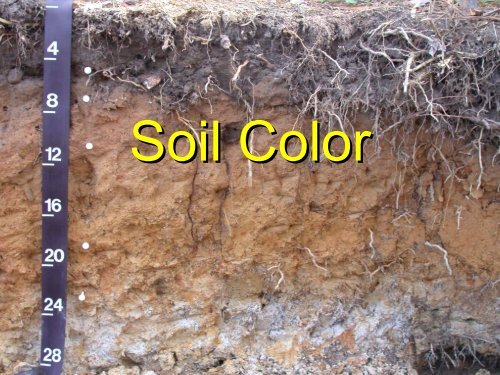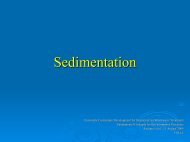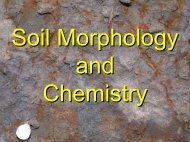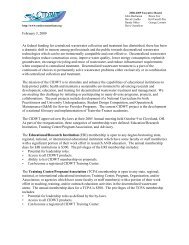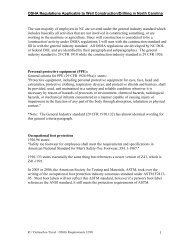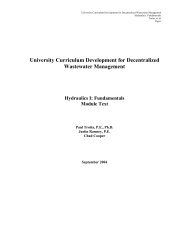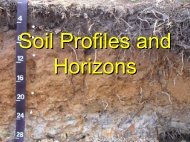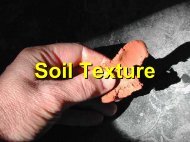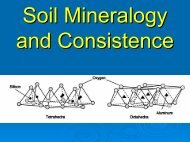Soil Color
Soil Color - Consortium of Institutes for Decentralized Wastewater ...
Soil Color - Consortium of Institutes for Decentralized Wastewater ...
- No tags were found...
You also want an ePaper? Increase the reach of your titles
YUMPU automatically turns print PDFs into web optimized ePapers that Google loves.
<strong>Soil</strong> <strong>Color</strong>
NDWRCDP Disclaimer<br />
This work was supported by the National Decentralized Water<br />
Resources Capacity Development Project (NDWRCDP) with<br />
funding provided by the U.S. Environmental Protection Agency<br />
through a Cooperative Agreement (EPA No. CR827881-01<br />
01-0) 0)<br />
with Washington University in St. Louis. These materials have<br />
not been reviewed by the U.S. Environmental Protection<br />
Agency. These materials have been reviewed by<br />
representatives of the NDWRCDP. The contents<br />
of these materials do not necessarily reflect the views and<br />
policies of the NDWRCDP, Washington University, or the U.S.<br />
Environmental Protection Agency, nor does the mention of trade<br />
names or commercial products constitute their endorsement or<br />
recommendation for use.
CIDWT/University Disclaimer<br />
These materials are the collective effort of individuals from<br />
academic, regulatory, and private sectors of the<br />
onsite/decentralized wastewater industry. These materials have<br />
been peer-reviewed reviewed and represent the current state of<br />
knowledge/science in this field. They were developed through a<br />
series of writing and review meetings with the goal of<br />
formulating a consensus on the materials presented. These<br />
materials do not necessarily reflect the views and policies of<br />
North Carolina State University, and/or the Consortium of<br />
Institutes for Decentralized Wastewater Treatment (CIDWT).<br />
The mention of trade names or commercial products does not<br />
constitute an endorsement or recommendation for use from<br />
these individuals or entities, nor does it constitute criticism for<br />
similar ones not mentioned.
Citation<br />
-Lindbo, D.L., M. H. Stolt, R. Miles, and D. L.<br />
Mokma. 2005. 3. Field Description of<br />
<strong>Soil</strong>s: <strong>Color</strong> – Power Point Presentation.<br />
in (D.L. Lindbo and N. E. Deal eds.) Model<br />
Decentralized Wastewater Practitioner<br />
Curriculum. National Decentralized Water<br />
Resources Capacity Development Project.<br />
North Carolina State University, Raleigh,<br />
NC.
‣ Why color?<br />
<strong>Soil</strong> <strong>Color</strong><br />
• It is the most obvious and easily<br />
determined soil characteristic. Important<br />
characteristics can be inferred from soil<br />
color.
<strong>Color</strong>ing agents in the soil<br />
‣ Organic matter darkens the soil. Organic matter will<br />
mask all other coloring agents.<br />
‣ Iron (Fe) is the primary coloring agent in the subsoil.<br />
The orange brown colors associated with well drained<br />
soils are the result of Fe oxide stains coating individual<br />
particles.<br />
‣ Manganese (Mn) is common in some soils resulting in<br />
a very dark black or purplish black color.
<strong>Color</strong> Patterns<br />
‣ Matrix color is the dominant color in the<br />
soil.<br />
‣ Mottling is spots or blotches of color in the<br />
soil that differ from the matrix color.<br />
‣ Redoximorphic features are mottles that<br />
relate to the aeration or drainage of the<br />
soil.
Elements of soil color<br />
‣ Coatings<br />
‣ Structural grains
Types of Coatings<br />
‣ Organic matter coatings<br />
‣ Fe and/or Mn coatings (Mineralogy)
Source of <strong>Soil</strong> <strong>Color</strong>s<br />
Material<br />
Composition<br />
<strong>Color</strong><br />
Manganese<br />
Hematite<br />
Goethite<br />
Hydrated<br />
Ferric Oxide<br />
MnO 2<br />
Fe 2 O 3<br />
FeOOH<br />
Fe(OH) 3 nH 2 O<br />
Purplish Black<br />
Red<br />
Yellow<br />
Red-Brown
Black organic coatings
Red: Hematite<br />
and Goethite<br />
Yellow: Goethite<br />
Gray: No coatings
Fe-oxide coatings
Why is color important?<br />
1 2 3
What color is this?
What color is this?
What color is this?
What are these colors?
Spectrum
PR<br />
Hue<br />
R<br />
P<br />
YR<br />
PB<br />
Y<br />
B<br />
GY<br />
BG<br />
G
Hue<br />
‣ Hue is a measure of the chromatic<br />
composition of light that reaches the eye,<br />
such as: red (R) or yellow (Y).<br />
‣ Hues (10R through 5Y) are divided into<br />
four segments of equal visual steps, For<br />
example, yellow-red (YR) hue are<br />
identified as 2.5YR, 5YR, 7.5YR, and<br />
10YR
Value<br />
0 1 2 3 4 5 6 7 8 9 10
Value<br />
‣ Value indicates the degree of lightness or<br />
darkness of a color relative to gray;<br />
‣ value extends from pure black (0/) to pure white<br />
(10/);<br />
‣ value is a measure of the amount of light that<br />
reaches the eye, gray is perceived as about<br />
halfway between black and white and has a<br />
value notation of 5/.<br />
‣ Lighter colors have values between 5/ and 10/;<br />
darker colors are between 5/ to 0/.
Chroma<br />
0 8
Chroma<br />
‣ Chroma is the relative purity or strength of the<br />
spectral color. Chroma indicates the degree of<br />
saturation of neutral gray by the spectral color.<br />
‣ chromas extend from /0 for neutral colors to /8<br />
as the strongest expression of the color;<br />
‣ Some cards have symbols such as N 6/. These<br />
are totally achromatic (neutral color), and have<br />
no hue and no chroma, only a value.
Hue, Value and Chroma
Munsell <strong>Color</strong> System<br />
‣ Hue refers to the dominant wavelength of light<br />
(red, yellow, green, etc.).<br />
‣ Value refers to the lightness and darkness of a<br />
color in relation to a neutral gray scale.<br />
‣ Chroma is the relative purity or strength of the<br />
Hue.<br />
‣ Notation<br />
• Hue Value/Chroma<br />
• 10YR 5/6
10YR Page
Gley <strong>Color</strong>s<br />
‣ Refer to colors on the Gley Pages<br />
‣ 10Y, 5GY, 10GY, 10G, 5BG, 5B, 5B, or<br />
5PB with value 4+ and chroma 1<br />
‣ 5G with value 4+ and chroma 1 to 2<br />
‣ N with value 4+<br />
‣ 5Y with value 4+ and chroma 1<br />
‣ Gray colors are not always Gley colors
Gley Pages
Recording <strong>Soil</strong> <strong>Color</strong>s<br />
‣ <strong>Soil</strong> should be moist...This is the most<br />
common way soil colors are recorded.<br />
‣ Always use sunlight. Do not use artificial<br />
light. Do not wear sunglasses or tinted<br />
glasses.<br />
‣ Always use a freshly exposed face or ped.<br />
Do not crush or rub the soil before getting a<br />
color.<br />
‣ Determine the matrix and all subordinate<br />
colors (mottles).
Size<br />
‣ 76 mm – extremely coarse<br />
‣ Rule of thumb<br />
• your thumb nail is approximately 15 mm<br />
• your pinkie finger nail is approximately 10 mm
Percent<br />
‣ 20% - many
Each 1/4 th<br />
of any one<br />
square has<br />
the same<br />
amount of<br />
black
Contrast<br />
‣ Faint<br />
‣ Distinct<br />
‣ Prominent
Faint Contrast<br />
‣ Evident only on close examination.<br />
‣ Same hue (page):<br />
• 0 to 2 units value change, and<br />
• 1 chroma change
Distinct Contrast<br />
‣ Readily seen but moderate to the color to<br />
which compared.<br />
‣ Same hue (page):<br />
• 2 to 4 units value change and<br />
•
Distinct Contrast (cont.)<br />
‣ Or a hue change of 1 color chart (page):<br />
•
Prominent Contrast<br />
‣ Strongly contrasting colors to which they<br />
are compared.<br />
‣ Same hue (page):<br />
• >4 value unit change and<br />
• >4 chroma unit change<br />
‣ Or a hue change of 1 color charts (page):<br />
• >2 value unit change and<br />
• >1 chroma unit change<br />
‣ Or a hue change of 2 or more pages
Note that the criteria for<br />
contrast for use of hydric<br />
soil indicators are<br />
different.
Example<br />
Prominent<br />
7<br />
6<br />
Distinct<br />
Value<br />
5<br />
4<br />
3<br />
Faint<br />
2<br />
1<br />
1<br />
2<br />
3<br />
4 5 6<br />
Chroma<br />
7<br />
8<br />
9
7.5Y<br />
10YR<br />
2.5YR<br />
5YR<br />
7.5YR<br />
2.5Y<br />
5Y<br />
Example<br />
Prominent<br />
Distinct<br />
Faint
Contrast<br />
Class<br />
Faint<br />
Distinct<br />
Prominent<br />
Code<br />
F<br />
D<br />
P<br />
Contrast<br />
Difference in <strong>Color</strong> Between<br />
Matrix and Mottle<br />
Hue<br />
same<br />
same<br />
same<br />
1 page<br />
same<br />
1 page<br />
2+ page<br />
Value<br />
0 to 2 to 0<br />
or<br />
and<br />
and<br />
and<br />
and<br />
or<br />
or<br />
or<br />
Chroma<br />
0
Example: <strong>Soil</strong> Ped<br />
Matrix – 10YR 4/4<br />
Coating – 10YR 5/6<br />
Lining – 5YR 5/8<br />
Depletion –10YR 4/1<br />
Depletion –2.5Y 4/3
Example<br />
Matrix<br />
10YR 4/4<br />
10YR 4/4<br />
10YR 4/4<br />
10YR 4/4<br />
Feature<br />
10YR 5/6<br />
5YR 5/8<br />
10YR 4/1<br />
2.5Y 4/3<br />
Contrast<br />
Distinct<br />
Prominent<br />
Distinct<br />
Distinct
Feature<br />
Matrix
Matrix<br />
Feature
Matrix<br />
Feature
Feature 1<br />
Feature 2<br />
Matrix
Feature 1<br />
Feature 2<br />
Matrix
Feature 1<br />
Feature 2<br />
Matrix


